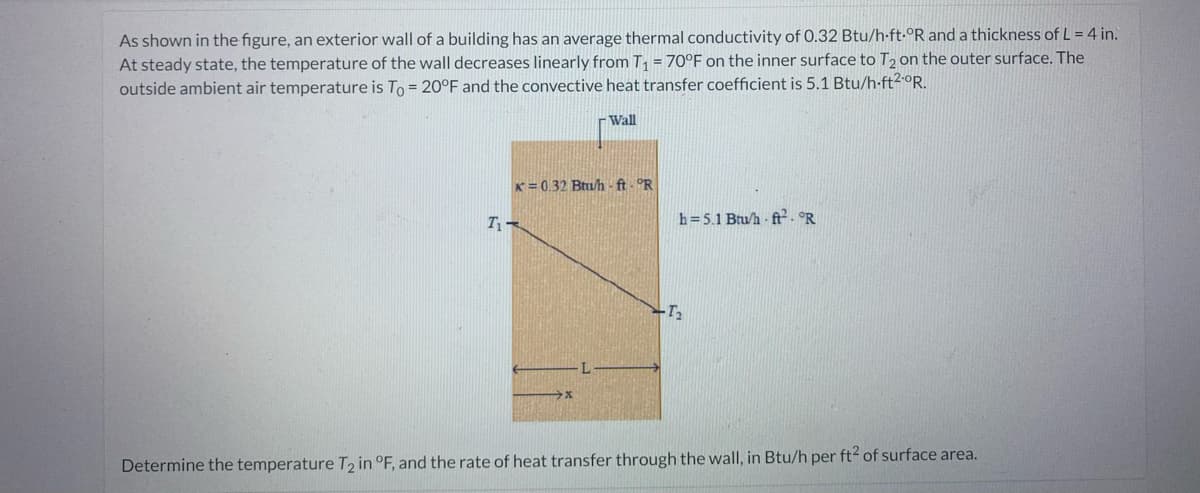As shown in the figure, an exterior wall of a building has an average thermal conductivity of 0.32 Btu/h-ft-ºR and a thickness of L = 4 in. At steady state, the temperature of the wall decreases linearly from T₁ = 70°F on the inner surface to T₂ on the outer surface. The outside ambient air temperature is To = 20°F and the convective heat transfer coefficient is 5.1 Btu/h-ft2°R. - Wall x=0.32 Btu/h-ft-R T₁- h=5.1 Btu/h ft. R T₂ Determine the temperature T2 in °F, and the rate of heat transfer through the wall, in Btu/h per ft2 of surface area.
As shown in the figure, an exterior wall of a building has an average thermal conductivity of 0.32 Btu/h-ft-ºR and a thickness of L = 4 in. At steady state, the temperature of the wall decreases linearly from T₁ = 70°F on the inner surface to T₂ on the outer surface. The outside ambient air temperature is To = 20°F and the convective heat transfer coefficient is 5.1 Btu/h-ft2°R. - Wall x=0.32 Btu/h-ft-R T₁- h=5.1 Btu/h ft. R T₂ Determine the temperature T2 in °F, and the rate of heat transfer through the wall, in Btu/h per ft2 of surface area.
Principles of Heat Transfer (Activate Learning with these NEW titles from Engineering!)
8th Edition
ISBN:9781305387102
Author:Kreith, Frank; Manglik, Raj M.
Publisher:Kreith, Frank; Manglik, Raj M.
Chapter2: Steady Heat Conduction
Section: Chapter Questions
Problem 2.1P: A plane wall, 7.5 cm thick, generates heat internally at the rate of 105 W/m3. One side of the wall...
Related questions
Question
16

Transcribed Image Text:As shown in the figure, an exterior wall of a building has an average thermal conductivity of 0.32 Btu/h-ft-ºR and a thickness of L = 4 in.
At steady state, the temperature of the wall decreases linearly from T₁ = 70°F on the inner surface to T₂ on the outer surface. The
outside ambient air temperature is To = 20°F and the convective heat transfer coefficient is 5.1 Btu/h-ft2°R.
Wall
x=0.32 Btu/h-ft-R
T₁-
h=5.1 Btu/h ft². °R
-T₂
Determine the temperature T₂ in °F, and the rate of heat transfer through the wall, in Btu/h per ft² of surface area.
Expert Solution
This question has been solved!
Explore an expertly crafted, step-by-step solution for a thorough understanding of key concepts.
This is a popular solution!
Trending now
This is a popular solution!
Step by step
Solved in 2 steps with 1 images

Knowledge Booster
Learn more about
Need a deep-dive on the concept behind this application? Look no further. Learn more about this topic, mechanical-engineering and related others by exploring similar questions and additional content below.Recommended textbooks for you

Principles of Heat Transfer (Activate Learning wi…
Mechanical Engineering
ISBN:
9781305387102
Author:
Kreith, Frank; Manglik, Raj M.
Publisher:
Cengage Learning

Principles of Heat Transfer (Activate Learning wi…
Mechanical Engineering
ISBN:
9781305387102
Author:
Kreith, Frank; Manglik, Raj M.
Publisher:
Cengage Learning